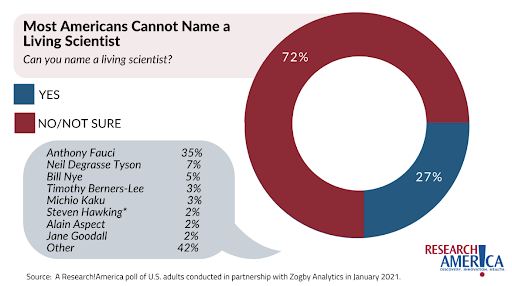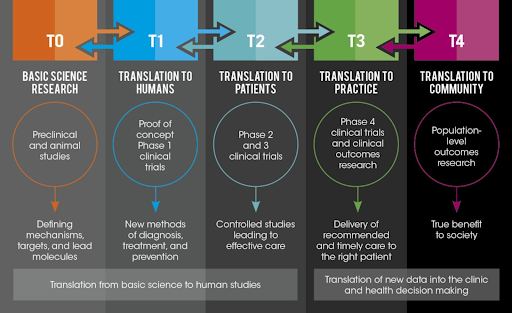Science and society have a symbiotic relationship. Approximately 50% of scientific research is funded by and dependent on taxpayer money (1,2) and society benefits from scientific discoveries that push forward the frontiers of knowledge. That said, the benefits of scientific discoveries are not as apparent or quantitative as the taxpayer money that funds it. Therefore, in addition to conducting research, scientists should give back to and involve society, through effectively communicating their research to the public.
National public opinion polls revealed that 27% of Americans cannot name a medical or health research institution and 72% cannot name a living scientist, (Fig. 1). Most notably, when asked, “Should scientists consider it part of their job to inform the public about their research and its impact on society?,” 80% of participants answered that they believed it was scientists’ job to communicate their research to the public (1,2). This poll, consisting of 1,000 participants, indicates that the public lacks awareness of scientific research and expects scientists to communicate it to them. This is a fair expectation when we consider the fact that taxpayer money pays for a considerable amount of research (1,2,3).
This blog post discusses my experience as part of the 2020-2021 Newkirk Center of Science & Society Research Justice Shop (RJS) fellowship. I will discuss how CBR can be a mutually beneficial practice for both scientists and society. Specifically, I will discuss how natural scientists’—life and physical scientists—can benefit from implementing certain CBR approaches into their research. CBR is a research approach where researchers and community stakeholders are both contributors in all steps of the research process with the goal of educating, improving practice, or social change (4,5,6,7). CBR is centered around the shared authority between the researcher and the researched, while acknowledging the legitimacy of knowledge provided by both (6).
As part of the RJS fellowship, an interdisciplinary team consisting of two fellows is matched with a community based organization (CBO) and are tasked with conducting a CBR project that RJS co-directors and the CBO contact person co-design. I worked with the Madison Park Neighborhood Association, Getting Residents Engaged in Empowering Neighborhoods (MPNA-GREEN). MPNA is a non-profit city-formed association established 35 years ago with the goal of serving community members in south-east Santa Ana, California. MPNA-GREEN provides educational opportunities and health and environmental resources to residents, and is strongly linked with the UCI community through ongoing collaborations. The goal of our CBR was to collaborate with MPNA-GREEN in establishing and developing sustainability and in building capacity internally in the organization. Our role involved helping MPNA-GREEN with recruitment of advisory board members (from youth, faculty and community) and developing sustainable ways for MPNA-GREEN to recruit in the future.
My experience with MPNA-GREEN as part of the RJS fellowship was very transformative for me as a neuroscience doctoral student. By sitting in on meetings with the MPNA-GREEN board, consisting of experts from different parts of the community (e.g. elementary school principal, residents, doctors, etc), I learned how important it is to involve community members in decisions that would either directly or indirectly impact them. In more traditional scientific research approaches, research undergoes several steps before actually being presented to the public and having an impact on communities (Fig 2). It would be beneficial to involve and educate communities at earlier stages in the scientific research process before the research has an impact on them. For example, the COVID-19 pandemic demonstrated the communication gap existing between scientific research and society. Regulations constantly changed, as scientists discovered more about the coronavirus. However, due to a lack of effective communication and trust, society became doubtful of scientists and reluctant to follow the changing regulations. When Dr. Fauci emphasized the need to take precautions to protect ourselves from the coronavirus, several communities were reluctant to accept this fact. This situation could have (in-part) been mitigated by a better communication relationship between the scientific research community and society.

I was introduced to the term “community return” through one discussion with our “point of contact” at MPNA-GREEN. When conducting CBR such as the RJS fellowship where a CBO is working with a university partner, a point of contact is typically an active member of the CBO. Given that one of our roles at MPNA-GREEN was to support advisory board recruitment, my RJS partner and I suggested providing incentives to recruit community members to the board. In this context “community return” was brought up as an incentive: meaning that seeing the positive effects and successes of MPNA was enough of an incentive to recruit individuals to the board. Community return refers to the benefits to the community that would follow in response to a certain action. MPNA members genuinely care about the well being of their community, and understand what their needs are. Furthermore, the well being of their community is enough of an incentive for most community members to devote their time and energy into being a board member. Collaborating with community members and CBO’s such as MPNA-GREEN in scientific research can aid in the development of effective communication between science and society.
One of My biggest takeaways from this experience was the transformative nature of CBR and the unity and strength of the MPNA-GREEN community.
Bio: Mulatwa Haile was a 2nd year PhD student in the Department of Anatomy and Neurobiology at the University of California, Irvine at the time she wrote this blog. She was a 2020-2021 Newkirk Fellow with the Research Justice Shop. You can Reach her through email (mthaile@uci.edu). For more information regarding the Research Justice Shop please visit the website or contact researchjustice@uci.edu or follow us on Facebook, Instagram, Twitter, and LinkedIn.
References
- Research America https://www.researchamerica.org/sites/default/files/2022%20January%20National%20Survey%20Results.pdf
- https://www.researchamerica.org/blog/survey-most-americans-cannot-name-living-scientist-or-research-institution
- Elizabeth Shockman SciFri Free access to scientific research comes at a cost. https://www.sciencefriday.com/segments/free-access-to-scientific-research-comes-at-a-cost/
- Green LW, George MA, Frankish DM, Herbert CJ, Bowie WR, O’Neill M. Recherche participative et promotion de la santé: Bilan et recommandations pour le développement de la recherche participative en promotion de la santé au Canada. Ottawa: Société royale du Canada; 1995
- Israel BA, Schulz AJ, Parker EA, Becker AB. Review of community-based research: assessing partnership approaches to improve public health. Annu Rev Public Health. 1998;19:173–202.
- Baum F, MacDougall C, Smith D. Glossary: participatory action research. J Epidemiol Community Health. 2006;60(10):854–7.
- Tremblay, M. C., Martin, D. H., McComber, A. M., McGregor, A., & Macaulay, A. C. (2018). Understanding community-based participatory research through a social movement framework: a case study of the Kahnawake Schools Diabetes Prevention Project. BMC public health, 18(1), 487.



Follow us